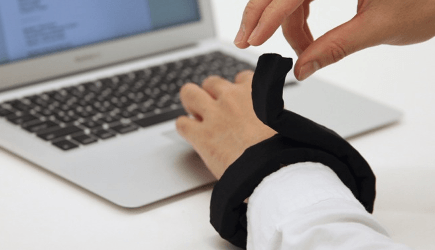LineForm: the Shape Shifting Human Computer Interface
November 19, 2015
on
on

Compared to the giant leaps forward in computing power, human computer interfacing has made little progress. We're still mostly hunched over screens, using our hands to input data. Researchers from MIT are exploring a new type of interface. No screen, no keyboard but a snake-like device that can display information and receive tactile input by changing shape.
A few years back I interviewed engineer Jelle Saldien who teaches at the Industrial Design Center in Kortrijk, Belgium. He pointed out that as the number of devices in our lives rises we need new types of interfaces: “In the near future we will have computers all around us without noticing them. This ties in with the advent of the Internet of Things (IoT). With the IoT, every product will also have a virtual presence on the Internet. Everything will be linked together then. The interface vision is a very important aspect of this, since you can’t use a keyboard to interact will all those products. If the products in your surroundings can respond to the input they obtain from your gestures or facial expressions, the boundary between the digital and physical worlds disappears.”
LineForm is definitely an original approach to interfacing. Ken Nakagaki, Sean Follmer and Hiroshi Ishii of the MIT Media Lab explored the possibilities of using a physical curve as an input and output device. In their research paper they call it “a novel class of shape changing-interfaces”.
LineForm is a chain of servo motors with 1 degree of freedom that can shift shape very much like a snake. It is covered with a spandex skin enhanced with pressure sensors to collect touch data. One of the use cases the team proposes is the smart wristband / phone. The user wears LineForm around her wrist, when a she receives a phone call LineForm tightens: giving haptic feedback to notify her. The outer servo-motor then curls back so the user can peal the band of her wrist. LineForm then assumes the form of an old-fashioned phone handset and with a tap on the pressure sensors the user answers the call.
The physical curve provides a surprising number of interface possibilities. The user can input commands through the touch sensors, by changing its shape or by pinching it. The MIT team offers the example of pinching the wire of a headphone set to skip to the next song while sliding along it adjusts the volume. (They did not implement this idea with LineForm).
As an output device LineForm has a number of options as well: It can display data in a physical form, for instance to represent part of a 3D model. It can take the shape of an iconic form, as in the case of the smart wristband / phone or it can represent a user interface element, such as a switch or a slider.
The entire project is still in its experimental phase but it is definitely in interesting new approach to interfacing. Here's a video of LineForm in action by the MIT Media Lab team.
Image: LineForm. By MIT Media Lab.
A few years back I interviewed engineer Jelle Saldien who teaches at the Industrial Design Center in Kortrijk, Belgium. He pointed out that as the number of devices in our lives rises we need new types of interfaces: “In the near future we will have computers all around us without noticing them. This ties in with the advent of the Internet of Things (IoT). With the IoT, every product will also have a virtual presence on the Internet. Everything will be linked together then. The interface vision is a very important aspect of this, since you can’t use a keyboard to interact will all those products. If the products in your surroundings can respond to the input they obtain from your gestures or facial expressions, the boundary between the digital and physical worlds disappears.”
LineForm is definitely an original approach to interfacing. Ken Nakagaki, Sean Follmer and Hiroshi Ishii of the MIT Media Lab explored the possibilities of using a physical curve as an input and output device. In their research paper they call it “a novel class of shape changing-interfaces”.
LineForm is a chain of servo motors with 1 degree of freedom that can shift shape very much like a snake. It is covered with a spandex skin enhanced with pressure sensors to collect touch data. One of the use cases the team proposes is the smart wristband / phone. The user wears LineForm around her wrist, when a she receives a phone call LineForm tightens: giving haptic feedback to notify her. The outer servo-motor then curls back so the user can peal the band of her wrist. LineForm then assumes the form of an old-fashioned phone handset and with a tap on the pressure sensors the user answers the call.
The physical curve provides a surprising number of interface possibilities. The user can input commands through the touch sensors, by changing its shape or by pinching it. The MIT team offers the example of pinching the wire of a headphone set to skip to the next song while sliding along it adjusts the volume. (They did not implement this idea with LineForm).
As an output device LineForm has a number of options as well: It can display data in a physical form, for instance to represent part of a 3D model. It can take the shape of an iconic form, as in the case of the smart wristband / phone or it can represent a user interface element, such as a switch or a slider.
The entire project is still in its experimental phase but it is definitely in interesting new approach to interfacing. Here's a video of LineForm in action by the MIT Media Lab team.
Image: LineForm. By MIT Media Lab.
Read full article
Hide full article


Discussion (0 comments)